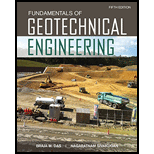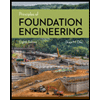
Concept explainers
(a)
State whether the statement “During consolidation, effective stress decreases” is true or false.
(a)
Answer to Problem 9.1P
The statement is False.
Explanation of Solution
Calculate the effective stress
Here,
Consolidation is the process to drain the water from the soil particle. The pore water pressure becomes zero during the consolidation. Hence, the total stress will increase due to zero pore water pressure.
Hence, the statement “During consolidation, effective stress decreases” is False.
(b)
State whether the statement “Compression index can be less or greater than the swelling index” is true or false.
(b)
Answer to Problem 9.1P
The statement is False.
Explanation of Solution
Consider the Boston blue clay soil.
Refer to Table 9.2 “Compression and Swell of natural soils” in the Text Book.
Take the value of compression index
Take the value of swell index
The value of compression index
Hence, the statement “Compression index can be less or greater than the swelling index” is False.
(c)
State whether the statement “The larger the coefficient of consolidation, the faster is the consolidation process” is true or false.
(c)
Answer to Problem 9.1P
The statement is True.
Explanation of Solution
“Coefficient of consolidation”
It is directly proportional to permeability, if the soil has high permeability then the “coefficient of consolidation” of the soil is high.
Hence, the statement “The larger the coefficient of consolidation, the faster is the consolidation process” is True.
(d)
State whether the statement “High plastic clays have higher
(d)
Answer to Problem 9.1P
The statement is False.
Explanation of Solution
The “coefficient of consolidation” is less for high plastic clay due to the plastic limit, that is the expel of water from high plastic clay is not as much the low plastic clay.
Hence, the statement “High plastic clays have higher
(e)
State whether the statement “The stiffer clay, the lower is the coefficient of consolidation” is true or false.
(e)
Answer to Problem 9.1P
The statement is False.
Explanation of Solution
The clay is stiff when the “coefficient of consolidation” is high and it is loose when the “coefficient of consolidation” is less.
Hence, the statement “The stiffer clay, the lower is the coefficient of consolidation” is False.
Want to see more full solutions like this?
Chapter 9 Solutions
Fundamentals of Geotechnical Engineering (MindTap Course List)
 Fundamentals of Geotechnical Engineering (MindTap...Civil EngineeringISBN:9781305635180Author:Braja M. Das, Nagaratnam SivakuganPublisher:Cengage Learning
Fundamentals of Geotechnical Engineering (MindTap...Civil EngineeringISBN:9781305635180Author:Braja M. Das, Nagaratnam SivakuganPublisher:Cengage Learning Principles of Geotechnical Engineering (MindTap C...Civil EngineeringISBN:9781305970939Author:Braja M. Das, Khaled SobhanPublisher:Cengage Learning
Principles of Geotechnical Engineering (MindTap C...Civil EngineeringISBN:9781305970939Author:Braja M. Das, Khaled SobhanPublisher:Cengage Learning Principles of Foundation Engineering (MindTap Cou...Civil EngineeringISBN:9781337705028Author:Braja M. Das, Nagaratnam SivakuganPublisher:Cengage Learning
Principles of Foundation Engineering (MindTap Cou...Civil EngineeringISBN:9781337705028Author:Braja M. Das, Nagaratnam SivakuganPublisher:Cengage Learning Principles of Foundation Engineering (MindTap Cou...Civil EngineeringISBN:9781305081550Author:Braja M. DasPublisher:Cengage Learning
Principles of Foundation Engineering (MindTap Cou...Civil EngineeringISBN:9781305081550Author:Braja M. DasPublisher:Cengage Learning



